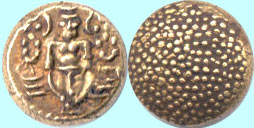



The Coins of the Dutch Overseas territories 1601-1948
J. Schulman, 1953, Amsterdam
X. COIN.S OF THE UNITED EAST INDIA COMPANY IN INDIA AND CEYLON
NEGAPATNAM
On July 23, 1658 the Dutch took Negapatnam (in Coromandel, 10° 46' N.L.) from the Portuguese after a short blockade and without striking a blow. Up to 1674 the Company steadily extended its power and possessions in the neighborhood of the town. In 1662 it was granted the half Mint Custom by a cawl or cession of the Nayak of Tanjore, a vassal of Madura, and on Sept. 22, 1674 the cawl was renewed. The Company enjoyed a mint custom of 3/4 % and its mintmaster enjoyed an equal amount.
In 1676 the country surrounding Negapatnam was plundered by the Mahrattas. From 1673 to 1680 it was under the Government of Ceylon and in 1690 it became the head office for the Coast of Coromandel. until, in 1784, the Dutch were forced to hand it over to the British.
It would appear that it was here that the Company, after receiving the mint custom in 1662, first struck a Pagoda of the type later generally known as the Novo type, with a convex reverse covered with dots (granulated). On the obv. bore it a standing deity. The granulated reverse took the place of the meaningless Nagari inscription on the Pulicat Pagodas.
The Mahrattas adopted this type with the granulated reverse and soon claimed the exclusive right of coining it. Later the Nawab of Arcot and the British did the same. This appears from the Res. of Nov. 5, 1677, according to which only Pagodas were to be struck again at Negapatnam.
The coinage of this type seems to have been stopped later, probably on the introduction in 1747 of the new Negapatnam Pagoda, which was again chiefly of the Porto Novo type. The Nawab of Arcot protested, but without success. The Gcvernor declared that the Court at Tanjore had granted him the right to issue Pagodas of any type and fineness he pleased and claimed that the Negapatnam Pagodas were distinguishable from the other Pagodas, by which he was apparently referring to the letter J or I which is clearly visible at the right in the "ringge", or wreath. For the general public this distinction will not have been very adequate but no doubt it was clear enough to the "shroffs" (the well_known Indian money_changers).
The granulated reverse was also used on the Three Swami Pagoda of the Northern Factories of the Coast. The English, who, as already pointed out, also imitated our Pagodas, later put a star in the centre of the granulated field as a distinguishing mark, the French a crescent, the Danes a crowned monogram C7, the Nawab the Arabic character šand Haidar Aly of Mysore the character m. It should be noted that these last marks resembled the French crescent so closely as to have been simply imitations of it.
Thus we see that, although it was imitated at Madras and Arcot, the granulated reverse without fiurther symbol remained the characteristic mark of the Pagodas struck by the Dutch.
The Porto Novo Pagodas were used on Ceylon in the elephant trade.
—138—